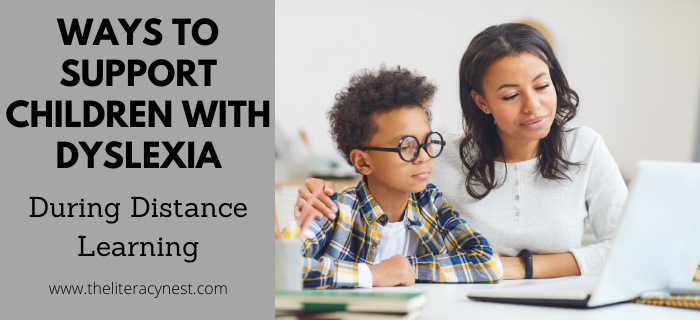Ways To Support Children with Dyslexia During Distance Learning

During these strange times we live in, many of us are wearing multiple hats. Parent, employee, teacher, student, educational guide. If your child is doing hybrid or remote schooling, then it is highly likely that some adult in your household is overseeing your child’s learning. For children with dyslexia and accompanying challenges, this style of learning may present some additional challenges.
One of these challenges may be assignments and their instructions being presented in writing rather than orally. Navigating a variety of different platforms may prove frustrating and means tools and strategies that may work for one teacher may not work for another if they are using different digital tools.
Another challenge our dyslexic kids face is not being able to connect with teachers in real time to read their work to them while it is fresh in their minds. This also makes on the spot guidance and corrections difficult for teachers. For our dyslexic kids with ADHD, the screen time may become problematic. As parents and educational guides, we must be fierce advocates for our children with dyslexia.
- Keep open lines of communication with the school and teachers. Stay in contact regularly and discuss how delivery of services and meeting the IEP will happen during distance learning. There are significant teaching shortages in some areas. The staff person assigned to your child’s cohort may not be an expert in dyslexia or familiar with your child as a learner. Be prepared to educate.
- Remember to advocate for your child to receive the appropriate accommodations. If distance learning means new accommodations are necessary, ask for them in writing. Advocating in an online setting may look different than in live school.
- Teach your child how to advocate for themselves in an online lesson. Asking a teacher to clarify a question is just one example.
- Some other specific online learning accommodations include:
- Don’t hesitate to read directions or assignments out loud when appropriate. Students are already working hard. If the directions would ordinarily be verbal, reading them aloud is reasonable.
- Keep in mind the goal of the assignment. If the students are learning about history or science, be liberal about acting as the child’s scribe or using assistive technology.
- Talk to the teacher about avoiding putting your child on the spot. Some children really struggle with being on video and a student that is uncomfortable being called on at random in a classroom may be doubly so via video conference. Agree on a signal for your child to indicate their willingness to answer.
- Ask the teacher to avoid situations where the child is being asked to do on demand writing on screen. Writing is a very slow process for many students with dyslexia and anxiety and pressure of feeling on display make it even more challenging.
- Some other specific online learning accommodations include:
- Create a dedicated space and consistent routine for learning. This is particularly important for students that struggle with attention or executive function.
- Take advantage of available technology. Use text to speech and speech to text when available. Ask about apps, assistive technology and audio books that can be helpful to your child. Ask for texts as hard copies or in a printable format if your child struggles with reading on a screen.
- Provide movement breaks. Remember that your child is working extra hard and needs a break to wiggle and move and use their big muscles.
- Move some activities offline. You know best how much screen time, is too much for your child. Instead of watching videos of stories online, read aloud to your child while cuddling on the couch. Our kids are under a lot of stress right now and one of our goals is to fill their cuddle buckets. Sharing stories together is a great way to do this.
- Make lemonade out of lemons. Remember the positives of a dyslexic thinker. Out of the box thinking, creative problem solving,and additional thinking time can all work to the advantage of a dyslexic learner. Use the technology to show off your child’s creativity. Instead of just sharing an essay or story as a Google doc, consider adding a voice recording of your child reading their piece. This allows a student who excels at drama to shine and makes it easier for the teacher to see your child as a whole learner rather than being overly influenced by their spelling and penmanship.
- Attend to your child’s hierarchy of needs. They need emotional and physical safety, exercise, food and water to be able to learn. While these needs sound clear, it can be difficult for children to meet all of them sitting at a computer all day. Make sure your child stays hydrated, takes a break for a good protein filled snack and that they build a trusting relationship with their online teacher. Work to establish an ergonomically correct workstation for your child to avoid neck aches and back pain. Keep open communication with your child regarding their feelings about school and the pandemic.

It is hard to know how to plan or what to do when we are on constantly changing ground. A parent of one of my students refers to the beginning of the pandemic as when everything went sideways. This strikes me as an excellent description. For many students, treading water, holding ground, concentrating on their social and emotional health is enough. But, for our students with dyslexia, there is no time to lose. We must ensure that we do the very best we can for them until life returns to something approaching normal.
Be sure to check out these distance learning posts !
Thank you for stopping by!







